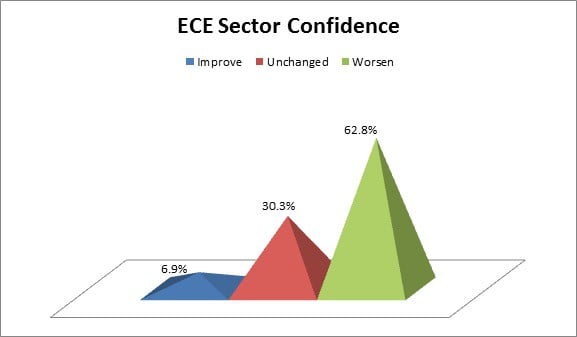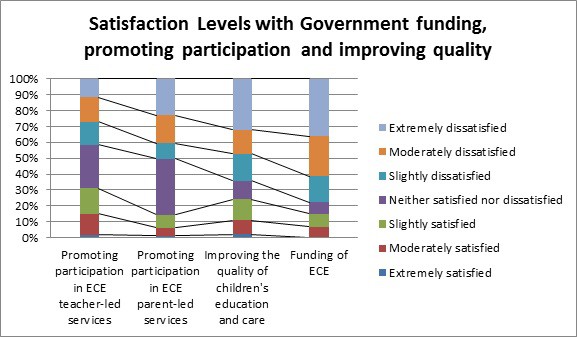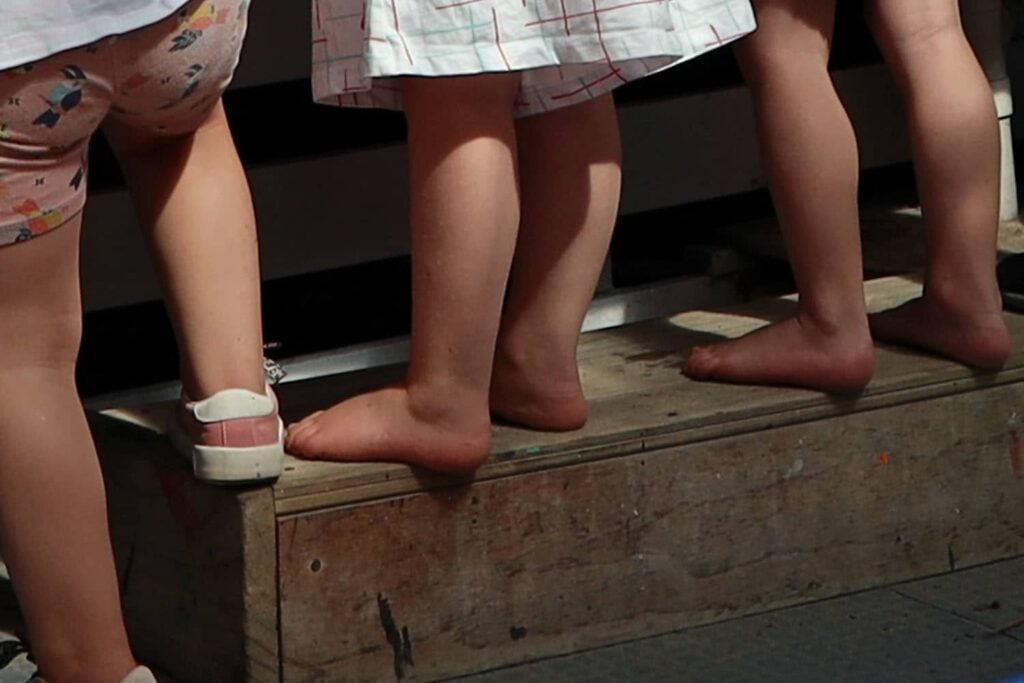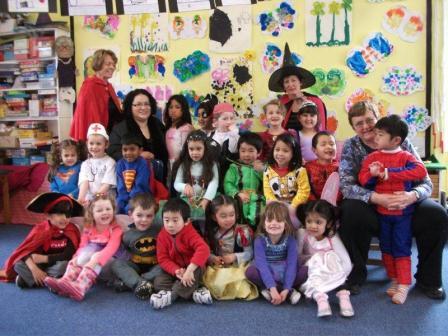Sector Confidence in the Government and Ratings of its Performance.
May 20, 2014.
About the Survey.
The survey was conducted online over one week in early May. A total of 360 people responded before the survey was closed.
Respondents included ECE owners, managers, and teachers, parents, teacher educators and others working in or with the ECE sector. They represented a diverse range of early childhood services including private and community based services, centre and home-based networks, teacher-led and parent-led services, language nests, and services with different philosophies (e.g. Montessori and Rudolf Steiner).
The survey asked people how they felt the Government was performing and what changes they would like to see, as well as how they felt things were going in the sector overall.
Confidence Levels
The first survey question asked how respondents thought things would change within the ECE sector over the coming 12 months.
Nearly two thirds of respondents (62.8%) felt that things were going to get worse. This compares with 56% from a similar survey in May 2013, which suggests the level of optimism within the sector is slipping. Just 6.9% of people in this year’s survey felt things would improve during the next 12 months compared to 10.4% in last year’s survey.

Nearly all of those who felt things might improve over the coming 12 months commented that this was because they anticipated a change of government and therefore a change of management for the sector. Many comments reflected the feeling that this was the only way things would improve.
Things have been getting worse every year since National took office and this is an election year.
I think it’s time for a change in government to make things better for ECE.
Better only if Labour gets in.
I think if National gets back in it will further divide ECE from other education sectors (i.e. Individual contracts for Kindy teachers).
A few respondents commented that the outlook for further growth in the sector with more enrolments was positive and that a restructure of the Ministry of Education at top management level could improve communication with early childhood services.
Funding issues were the most common reason given for not being confident of improvement.
Further tightening of money to ECE. It may be hidden because it is election year, but it will happen and take effect from next year.
Considering the current government’s plan, worse for sure as their focus is not on addressing socio-economic factors of children; nor how ECE services survive with the ongoing increase of costs when they are not part of a massive ECE organisation but only a small business.
More pressure on teachers and not enough money for staff wages.
More kids in our area and no more resources.
Funding will be reduced to volunteer based ECE providers and increased for paid “Qualified” teachers with no regard to the training given in volunteer ECE settings.
Increased competition, increasing costs, and administration burdens were also listed as reasons for concern.
Too many new centres being licensed. Too much competition and not enough children.
Pasifika Language nests centres will have to make a few changes in order to suit the government’s changes.
Pressure from government on getting solo parents back into the workforce and the increased cost of living especially in Christchurch.
Beginning of extra paperwork and change of assessments that are not developmentally appropriate for this age group.
I’m concerned about the current conversation about making ECE teachers more accountable and the push for academic learning in ECE. Children’s right to play needs to be protected. It is already compromised once children turn five. Instead ECE and Te Whariki should push into the early years at school.
I feel there is a trend towards formalising ECE and getting children ready for school. Parents are starting to believe that their children need to be educated through formal teaching methods.
More expectations that our curriculum will meet the school curriculum. Instead of school readiness the expectation will be curriculum readiness, with more testing as in schools.
With the government taking funding away for professional development and registration, teachers will find it hard to keep up to date.
Because the government doesn’t seem to care what happens in ECE as long as they are seen to be funding it enough.
It’s easy for the government to promote an increase in funding for targets, service, or purpose to look good to the public while undermining overall quality to all children.
Satisfaction with Government Performance in Key Policy Areas
The second part of the survey asked respondents how they felt the Government was performing in three main policy areas: promoting participation in ECE, funding, and raising the quality of ECE for children.
Respondents were asked to rate their satisfaction with government’s performance in promoting participation in teacher-led services and parent-led services separately to see if respondents perceived a difference in the way the two groups were treated.
The results are shown in the chart below.

The majority of respondents were dissatisfied with the government’s performance in increasing participation in early childhood education.
Just under a third of respondents (31%) said they were happy with performance in increasing participation in teacher-led services. Even fewer were happy with the promotion of parent-led services with just 14.5% of respondents satisfied. Many of the concerns centred on the perception that the Government was concentrating too strongly simply on increasing the numbers of children in ECE and the hours for which they attended. There were also concerns that the focus was on pushing children into all-day teacher-led services over other forms of early childhood education, such as sessional (part-day) kindergartens and parent-led options such as Playcentre.
Many comments showed a feeling that the Government was favouring quantity of participation over children’s needs and the best outcomes for children.
There is no equality in this promotion. Based on funding levels promotion is aimed squarely at having children in ECE for as many hours as possible – often in a care rather than an educationally focused environment. Kindergartens are being forced to extend session times because of funding levels.
The push seems to be all about getting the child out of the home so the parent can work. It is about the opportunity cost of the parent in the paid workforce rather than the best outcome for the child.
Telling a parent they have to send their child or else their benefit will be cut is unacceptable. It creates bad attitudes to education in general and puts extra strain on the centres, putting them into a “Policeman” role. The frequent absence rule is causing many centres to get parents to lie about hours. It is one great big mess!
The focus is too heavily on the last small percentage of children not attending without caring about what is happening for the vast majority who are attending.
It does not feel like any of the current policies support these (parent-led) kinds of ECE.
How does the government promote it? The Ministry team responsible for getting kids into ECE don’t promote us as I asked and they said they don’t. So no, actually the government is destroying Playcentre.
Satisfaction with Government performance in the two other areas, funding and raising quality for children in early childhood education, was even lower. Just 15% in total felt that performance in funding was satisfactory while 24% of respondents were happy with how the Government was addressing quality issues for children and improvement in the sector. Many respondents were unhappy with lack of funding for services (particularly due to raising costs and the earlier cutback of funding for 100% qualified teachers). Several said their services (especially non-commercial community-based ones) were struggling.
Government is funding childcare business at the expense of kindergarten, Playcentre, Kohanga and community based services.
We can barely exist on the funding allocated and may have to close our hundreds of centres due to lack of funds.
Our centre continues to provide 100% qualified teaching staff for our children as a commitment to providing quality ECE. We are struggling to maintain this action under a government that continues to cut our funding.
Higher costs and low funding= less quality education. I need to pay my teachers a good wage and want to give quality, which we have done but now we are in financial straits.
Raising the number of hours a child spends in ECE per week does not equate to raising quality of care and education, but that is what the policies are suggesting is the government’s view.
Often accountability gets in the way of what’s good for children. Policies should be more child centred.
What the ECE Sector Wants and Needs Most
The third part of the survey asked what respondents would like to see the Government focus on. Across all respondents, the most popular policy ideas and changes wanted were:
1st – Changing regulations to improve the current ratio of 1 adult to every 5 infants to 1:4
2nd – Restoring funding for services employing 100% registered teachers
3rd – Limiting the number of children in groups/classes within a service’s licence
4th – A review of community-based services, with discussion as to how these services could be better supported
5th – Lifting the minimum requirement for the percentage of qualified teachers in teacher-led services from 50% to 80%
6th – Making funding equitable across licensed early childhood services, i.e. the same amount of funding per child per hour whatever service the child attends
7th – Dropping the 6-hour daily limit rule for the 20-hours ECE funding scheme
8th – Increasing the 30-hour subsidy amounts for children of all ages in ECE
9th – Increasing the 20-hours ECE funding scheme to 25 hours
10th – Giving parents a choice in using the childcare subsidy to pay for care at a centre, with a nanny or home-based educator, or to stay-at-home and be their child’s educator.
The lowest ranked possible policy options were a review of the curriculum document Te Whāriki and making ECE compulsory for four-year-olds. These were ranked very low compared to other options, suggesting that these were viewed to be substantially less important by nearly all respondents.
Below, the results are broken down to show the most popular choices among different groups of respondents. While there are similarities, this breakdown shows that different groups within the sector have different priorities and what these are.
Teachers most wanted:
1st – Regulations changed to improve the current ratio of 1 adult to every 5 infants to 1:4
2nd – Funding restored for services employing 100% registered teachers
3rd – A limit placed on the number of children in groups/classes within a service’s licence
ECE Service Managers most wanted:
1st – Regulations changed to improve the current ratio of 1 adult to every 5 infants to 1:4
2nd – Funding restored for services employing 100% registered teachers
3rd – The 30-hour subsidy amounts increased for children of all ages in ECE
Owners most wanted:
1st – The 30-hour subsidy amounts increased for children of all ages in ECE
2nd – Regulations changed to improve the current ratio of 1 adult to every 5 infants to 1:4
3rd – The 6-hour daily limit rule for 20-hours ECE funding dropped and (3rd equal) the 20-hours ECE funding scheme increased to 25 hours
Parents most wanted:
1st – A review of community-based services, with discussion as to how these services could be better supported
2nd – Regulations changed to improve the current ratio of 1 adult to every 5 infants to 1:4
3rd – Parents given choice in the use of the childcare subsidy to pay for care at a centre, with a nanny or home-based educator, or to stay-at-home and be their child’s educator
Tertiary educators/ECE training providers most wanted:
1st – Regulations changed to improve the current ratio of 1 adult to every 5 infants to 1:4
2nd – A review of community-based services, with discussion as to how these services could be better supported
3rd – A limit placed on the number of children in groups/classes within a service’s licence
Kindergarten people most wanted:
1st – Funding restored for services employing 100% registered teachers
2nd – Regulations changed to improve the current ratio of 1 adult to every 5 infants to 1:4
3rd – A limit placed on the number of children in groups/classes within a service’s licence
Playcentre people most wanted:
1st – A review of community-based services, with discussion as to how these services could be better supported
2nd – Funding made equitable across licensed early childhood services
3rd – Parents given choice to use the childcare subsidy to pay for care at a centre, with a nanny or home-based educator, or to stay-at-home and be their child’s educator
Community-based childcare centre people most wanted:
1st – Funding restored for services employing 100% registered teachers
2nd – Regulations changed to improve the current ratio of 1 adult to every 5 infants to 1:4
3rd – A review of community-based services, with discussion as to how these services could be better supported
Private/ commercial childcare centre people most wanted:
1st – Funding restored for services employing 100% registered teachers
2nd – Regulations changed to improve the current ratio of 1 adult to every 5 infants to 1:4
3rd – The minimum requirement for the percentage of qualified teachers in teacher-led services lifted from 50% to 80%
Home-Based ECE Network people most wanted:
1st – Funding made equitable across licensed early childhood services
2nd – ECE qualified teachers who are working as home-based educators allowed to maintain teacher registration
3rd – Parents given choice to use the childcare subsidy to pay for care at a centre, with a nanny or home-based educator, or to stay-at-home and be their child’s educator
Conclusion
The survey results suggest that the ECE sector is not a happy one, and that the outlook for the future is not good.
The comments and the fact confidence levels have declined from the previous year also suggest that the current Government is out of step with the sector on the priorities for early childhood education and that it needs to move to reassure the sector it is working for ECE rather than against it.
While some in the sector are satisfied with the moves made to increase participation in teacher-led early childhood education, serious concerns remain that the Government is focusing too much simply on numbers and is not thinking enough about the quality of education and about how the range of choices for parents is decreasing.
The differing priorities found in the analysis of groups also show that the political parties need to be aware that policies may have a range of implications and should be careful not to focus too much on any one part of the sector to the detriment of others.
With the general election looming, it is more important than ever that each political party listens carefully to those in the ECE sector and works hard to create policies and funding strategies that focus on quality and choice, which it is apparent are the priorities for parents, teachers and ECE service leaders. Above all, policies should be rooted in an understanding of what is best for children and families and what makes early childhood education great.








